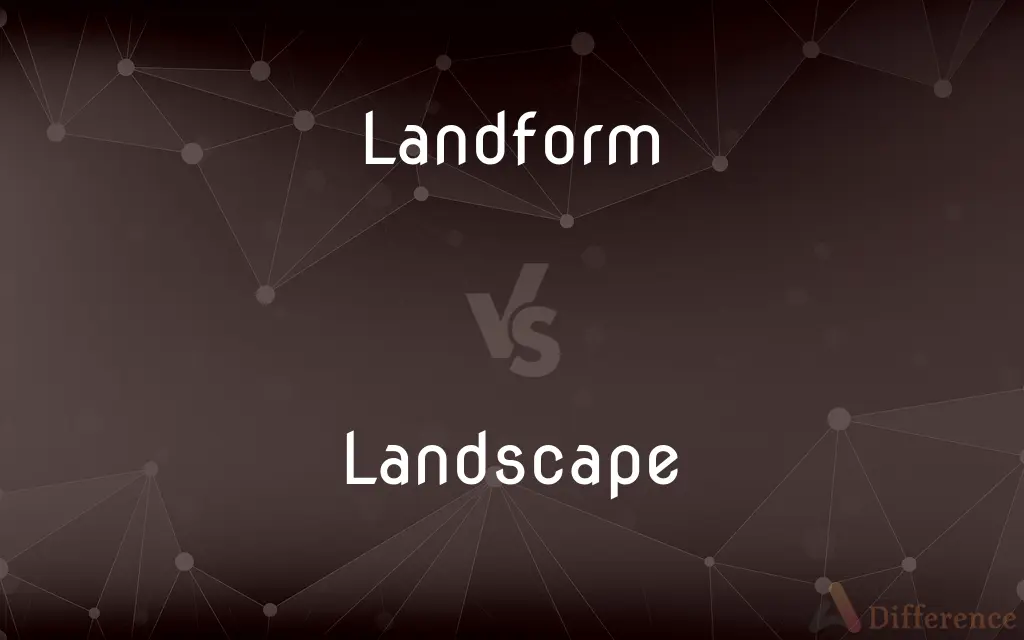Landform vs. Landscape — What's the Difference?
By Fiza Rafique & Urooj Arif — Updated on February 29, 2024
Landforms are natural physical features of the earth's surface, like mountains and valleys, while landscapes encompass the visible features of an area, including landforms, vegetation, and human elements.

Difference Between Landform and Landscape
Table of Contents
ADVERTISEMENT
Key Differences
Landforms refer to individual natural features of the earth's surface, shaped by processes like erosion and sedimentation, including mountains, valleys, plains, and rivers. Landscapes, however, are broader, encompassing the overall appearance of an area, which includes landforms, vegetation, water bodies, and human-made structures.
Landforms are specific shapes and structures within the earth's topography, such as hills or deltas, landscapes represent the composite of various elements, including these landforms, creating a distinct visual and environmental character for a region. Landscapes can be natural, like a forested area with rivers, or modified by human activities, such as a cityscape with parks and buildings.
The study of landforms, or geomorphology, focuses on understanding the processes that shape the earth's surface. In contrast, landscape studies, or landscape ecology, consider the interactions between physical, biological, and cultural components within an area. This includes how landforms influence the distribution of plants and animals, as well as human land use.
Landforms are the building blocks of landscapes. For example, a mountain range is a landform, while the landscape might include the mountain range along with surrounding forests, rivers, and wildlife, plus human elements like towns and roads. The relationship between landforms and landscapes is integral to planning and environmental conservation, influencing decisions on development, conservation, and land use.
Despite their differences, both landforms and landscapes are crucial for biodiversity, providing habitats for various species. Conservation efforts often aim to preserve unique landforms and their encompassing landscapes to maintain ecological balance and protect natural beauty.
ADVERTISEMENT
Comparison Chart
Definition
Natural physical feature of the earth's surface
Overall visible features of an area, including landforms, vegetation, and human elements
Scope
Specific, individual elements like mountains, valleys
Broad, encompassing natural and human-made features
Focus
Geomorphological features and processes
Interaction of physical, biological, and cultural components
Examples
Mountains, rivers, plains, valleys
Forest landscapes, urban landscapes, agricultural landscapes
Study
Geomorphology
Landscape ecology, landscape architecture
Compare with Definitions
Landform
A component of the earth's surface, such as a delta or glacier.
The Mississippi Delta is a fertile landform shaped by sediment deposits.
Landscape
The overall appearance of an area, including natural and human-made elements.
The Tuscan landscape is renowned for its rolling hills, vineyards, and historic villas.
Landform
A physical shape or structure that defines part of the earth's topography.
The Himalayas, a landform, rise dramatically above the surrounding plains.
Landscape
The visible features of an area of land, including topography, vegetation, and land use.
The landscape of the Great Plains includes vast open spaces and agricultural land.
Landform
A natural feature of the earth's surface, such as a mountain or valley.
The Grand Canyon is an impressive landform created by river erosion.
Landscape
A broad geographical area with distinct visual features and ecosystems.
The Amazon rainforest landscape is a biodiversity hotspot.
Landform
A natural terrain feature, including hills or dunes.
Sand dunes, shaped by wind, are dynamic landforms found in desert landscapes.
Landscape
The combined view of landforms, vegetation, and human alterations.
Rural landscapes often include a mix of fields, forests, and small towns.
Landform
An identifiable natural landscape feature, like a plateau or isthmus.
The Florida Keys are a series of coral cay archipelagos, a unique landform.
Landscape
A setting or environment that includes physical, biological, and cultural components.
Urban landscapes are shaped by buildings, parks, and human activity.
Landform
A landform is a natural or artificial feature of the solid surface of the Earth or other planetary body. Landforms together make up a given terrain, and their arrangement in the landscape is known as topography.
Landscape
A landscape is the visible features of an area of land, its landforms, and how they integrate with natural or man-made features. A landscape includes the physical elements of geophysically defined landforms such as (ice-capped) mountains, hills, water bodies such as rivers, lakes, ponds and the sea, living elements of land cover including indigenous vegetation, human elements including different forms of land use, buildings, and structures, and transitory elements such as lighting and weather conditions.
Landform
One of the features that make up the earth's surface, such as a plain, mountain, or valley.
Landscape
All the visible features of an area of land, often considered in terms of their aesthetic appeal
The soft colours of the Northumbrian landscape
A bleak urban landscape
Landform
Any geological feature, such as a mountain or valley.
Landscape
Denoting a format of printed matter which is wider than it is high
Landscape format
Landscape
An expanse of scenery that can be seen in a single view
A desert landscape.
Landscape
To arrange grounds aesthetically or maintain grounds as a profession.
Landscape
A picture representing a scene by land or sea, actual or fancied, the chief subject being the general aspect of nature, as fields, hills, forests, water. etc. Compare seascape.
Landscape
The pictorial aspect of a country.
The landscape of his native country had taken hold on his heart.
Landscape
An expanse of scenery that can be seen in a single view
Landscape
An extensive mental viewpoint;
The political landscape looks bleak without a change of administration
We changed the landscape for solving the proble of payroll inequity
Landscape
Embellish with plants;
Let's landscape the yard
Landscape
Do landscape gardening;
My sons landscapes for corporations and earns a good living
Common Curiosities
How do landforms affect landscapes?
Landforms are the physical foundation of landscapes, influencing their shape, climate, vegetation, and human use.
What is a landform?
A landform is a natural physical feature of the earth's surface, like a mountain, valley, or river.
What is the study of landforms called?
The study of landforms is called geomorphology.
Can landscapes include urban areas?
Yes, landscapes can include urban areas, where buildings, roads, and parks form the urban landscape.
Are all landscapes natural?
Not all landscapes are natural; many are shaped or altered by human activities, creating cultural or urban landscapes.
Can a desert be a landscape?
Yes, a desert is a type of landscape characterized by its dry climate, sand dunes, and sparse vegetation.
How are landscapes important to ecosystems?
Landscapes are important to ecosystems as they provide habitats for wildlife and influence climate and vegetation patterns.
How do humans impact landscapes?
Humans impact landscapes through construction, agriculture, urbanization, and conservation efforts, altering natural features and creating new ones.
What defines a landscape?
A landscape is defined by the overall visible features of an area, including landforms, vegetation, water bodies, and human-made elements.
Can a single landform be considered a landscape?
A single landform contributes to a landscape but does not constitute a landscape on its own, as landscapes encompass a broader range of features.
How do climate and geography influence landscapes?
Climate and geography are major influences on landscapes, determining the types of vegetation, landforms, and ecosystems that can exist in an area.
What is the significance of landscapes in cultural identity?
Landscapes often hold cultural significance, reflecting historical land use, spiritual values, and aesthetic preferences, contributing to a community's identity and heritage.
Is landscape architecture the same as landscaping?
Landscape architecture is a professional field focusing on designing outdoor areas, while landscaping refers to the process of making a yard or garden more attractive by altering the existing design, adding ornamental features, and planting trees and shrubs.
What role do water bodies play in landscapes?
Water bodies, like lakes and rivers, are key components of landscapes, influencing climate, supporting biodiversity, and shaping landforms.
How do conservation efforts target landscapes?
Conservation efforts target landscapes by protecting natural areas, restoring damaged ecosystems, and promoting sustainable land use to preserve biodiversity.
Share Your Discovery

Previous Comparison
Order vs. Chaos
Next Comparison
Glyceraldehyde vs. DihydroxyacetoneAuthor Spotlight
Written by
Fiza RafiqueFiza Rafique is a skilled content writer at AskDifference.com, where she meticulously refines and enhances written pieces. Drawing from her vast editorial expertise, Fiza ensures clarity, accuracy, and precision in every article. Passionate about language, she continually seeks to elevate the quality of content for readers worldwide.
Co-written by
Urooj ArifUrooj is a skilled content writer at Ask Difference, known for her exceptional ability to simplify complex topics into engaging and informative content. With a passion for research and a flair for clear, concise writing, she consistently delivers articles that resonate with our diverse audience.
















































